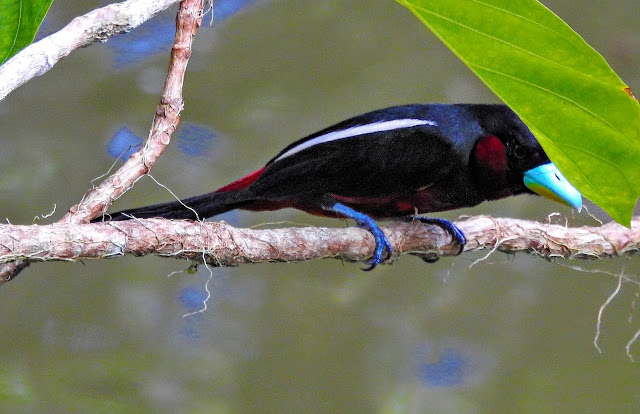The black-and-red broadbill is found in Brunei, Cambodia, Indonesia, Laos, Malaysia, Myanmar, Singapore, Thailand, and Vietnam. In peninsular Thailand, it has vanished locally from some areas. It was also common in Singapore until the 1940s, after which it was not recorded until 2004, and then 2020. It mainly inhabits riparian forest edges up to altitudes of 300 m (980 ft) throughout its range, although it can sometimes be found up to altitudes of 900 m (3,000 ft) m. In areas further downstream, it inhabits screw-palm swamps near the edges of mangroves. In areas affected by heavy land-conversion, it inhabits rubber plantations and coconut groves or orchards that have water channels. It has also been observed in peat swamp forest, but rarely enters closed-canopy forest. It can adapt quite well to disturbed habitat, surviving in secondary forest that has some tall trees remaining, as well as secondary vegetation with clumps of forest in pastureland. It also inhabits seriously degraded habitats along rivers.
This Blog contains Wildlife, Plants and Bird Photos from Walks, Safaris, Birding Trips and Vacations. Most of the pictures have been taken with my Nikon P900 and P950X cameras. Just click on any image for a larger picture. On the right column under the Blog Archive are the entries by date. Below that under Animal categories all the diffent species of Animals, Birds, Insects and Plants contained in the website are listed. Clicking on any entry will show all the entries for that species.
TOTAL PAGEVIEWS
TRANSLATE
Friday, 21 July 2023
Sunday, 9 July 2023
22-5-2023 SUKAU RIVER LODGE, BORNEO - BLACK AND RED BROADBILL (Cymbirhynchus macrorhynchos)
The black-and-red broadbill (Cymbirhynchus macrorhynchos) is a species of bird in the typical broadbill family, Eurylaimidae. It is the only species in the genus Cymbirhynchus. A large, distinctive bird, it has maroon underparts, black upperparts, a maroon neck-band, and white bars on the wings. It also has a large, two-colored, blue-and-yellow bill. The species shows slight sexual dimorphism, with females being smaller than males. No other bird in its range resembles it, though the black-and-yellow broadbill has a similar call.
The species is found in Brunei, Cambodia, Indonesia, Laos, Malaysia, Myanmar, Singapore, Thailand, and Vietnam. Inhabiting lowland riparian forest throughout its range, it can also adapt quite well to disturbed habitat, such as secondary forest growth and degraded habitat near rivers. The black-and-red broadbill is mainly insectivorous, supplementing its diet with aquatic creatures such as mollusks, snails, fish, and crustaceans. It also takes leaves and seeds incidentally.
Breeding takes place during the dry season throughout its range, with the nest being a large, conspicuous structure that usually hangs over water. Nests are built by both sexes, out of creepers, fungal hyphae, moss, and other plant matter. Eggs are laid in clutches of two or three, occasionally with a fourth runt egg, and incubated by both parents. The black-and-red broadbill is evaluated as a least-concern species by the International Union for Conservation of Nature due to its large range and the lack of a severe decrease in its global population. However, the species has experienced declines in several parts of its range, and may face threats due to deforestation, trapping for the songbird trade, and hunting.
The black-and-red broadbill is mainly found singly, in pairs, or in family parties. The species has been known to roost in small groups. There are occasional records of multiple adults vocalizing together, which are thought to be territorial encounters. The species has a generation length of three years.


%201.jpg)
%202.jpg)
%203.jpg)